While we’re all for timeless, classic design, it’s always fun to spot new furniture trends, and refresh your space with the very latest in interior design.
Whether you’re looking for a new sofa, side table or are simply intrigued by the 2025 furniture trends forecast by designers, the new year is often a time when we start to explore the latest interior design trends, and think about updating existing pieces of furniture in our homes.
To help guide you in the right style direction and offer the very latest insight from the experts, we have curated a collection of the top furniture trends you need to know about for the year ahead.
10 furniture trends set to dominate design in 2025
There is a lot to explore and unpack for 2025 furniture trends; from curvaceous silhouettes to statement stoneware and reclaimed styles of the past, these are the top 10 looks and design ideas that will shape furniture styles this year.
1. Finely crafted wooden furniture
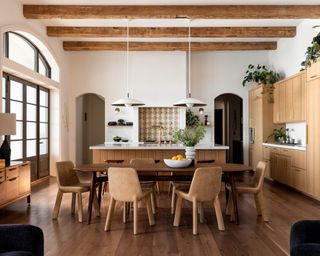
(Image credit: Hoedemaker Pffeifer / Haris Kenjar)
‘Finely crafted, sculptural wooden furniture will never go away, wood continues to enrich our spaces with warmth, inviting natural character, and a sense of grounding familiarity, therefore it will always be timeless. I’m very much looking forward to seeing how this style of furniture will evolve, especially the integration of handcrafted artisanal furniture from bespoke woodworker designers,’ says Tim Pfeiffer, interior design partner of Hoedemaker Pfeiffer.
Designer Joanna Hauptman, co-founder of British furniture manufacturers, Hyde House also agrees and says, ‘The return to timber in its natural state, in the form of both reclaimed wood and in veneer from oak to mahogany, will be championed. Specialist finishes like birds eye maple and walnut burr can add real depth to a piece, creating a wonderful design statement in a space.’
2. Fluted kitchen cabinetry
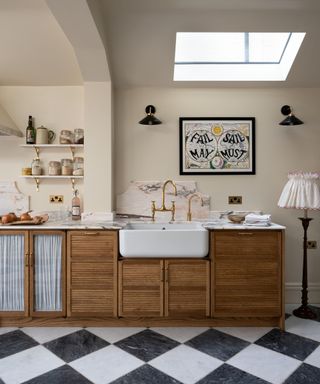
(Image credit: deVOL Kitchens / Good Bones London)
Fluted cabinets provide both a textural and rustic finish, bringing an old-fashioned charm reminiscent of wooden shutters. Falling under the overarching theme of vintage-style decor, fluted cabinetry harks back to vintage styles.
DeVOL kitchens incorporate fluted cupboards in their ‘Haberdasher’s style’ kitchens, linking to the past furnishings of midcentury apothecary and sewing stores. Helen Parker, Creative Director of deVOL Kitchens says, ‘Our Haberdasher’s cupboards are available in a fluted finish, a unique look inspired by the popular mid-century sliding tambour doors.’
During the design process, the DeVOL team wanted to ensure authenticity when creating a retro-inspired kitchen. Paul O’Leary, Founder of deVOL Kitchens, said, ‘Flat-panel doors didn’t suit the aesthetic of this mid-century style kitchen, but we decided to take a lead from tambour-style doors that were popular in the ’70s. We made them from around thirty oak slats slotted into a door frame, with horizontal dividers that lined up with the drawers. The cupboards make a statement, with many familiar elements that all sit somewhere between the ’30s and ’70s.’
3. Soft and inviting curves
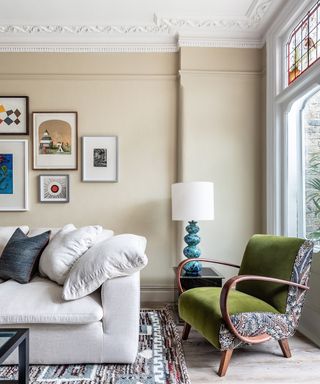
(Image credit: Angel O’Donnell)
With its soft and inviting qualities, it’s hardly surprising that curved furniture has been fawned over for the past year. The good news is, it’s here to stay. Who doesn’t want a soft and inviting sofa? Comfort is crucial to furniture, so we can see why this popular style choice remains.
Gray Walker, director of Gray Walker Interiors will continue to incorporate curved surfaces and plushy furniture in her designs, saying ‘curved lines on furniture pieces are here to stay. A feeling of comfort and ease will exude in a room with soft edges.’
Going down the curved route is best when it comes to choosing furniture for communal spaces as it dismisses any severity that angular pieces can often bring. But remember to consider a balance, as too many curves could feel too playful. Nina Lichtenstein suggests ‘incorporating round rugs and angular accents like geometric art or rectangular tables as they will counteract the softness of curvaceous furniture.’
Anna Sheridan, a London-based interior stylist, has a slightly different take on the trend and says, ‘The curved sofas trend is seemingly here to stay, but I’m welcoming the emergence of its cooler, sleeker sister: angular modular sofas. Still a maximalist addition to any home, I can’t help but feel excited for the upgrade. I would pair it with a fluid and organic-shaped coffee table to soften.’
4. Unexpected upholstery
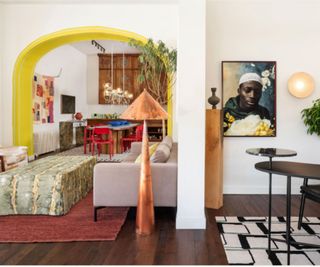
An upholstered statement ottoman is featured in this vibrant living room designed by Prospect Refuge.
(Image credit: Prospect Refuge Studio, Caylon Hackwith)
Fabric surfaces provide tactile ease and warmth vital for all types of communal spaces, be it a living room or a entryway. While untouched, original pieces are often beautiful, too many hard surfaces can produce a stark and cold quality. The initial arrival into a room should feel like a welcome greeting, and upholstered furniture does just that.
Whilst upholstering has been a traditional technique for centuries, there’s been a growing revival in using unexpected fabrics and furniture to create show-stopping, statement designs.
Victoria Sass design director of Prospect Studio has been creating uniquely upholstered designs and is excited to see its popularity rise over the coming year. When asked about new furniture trends she said, ‘Don’t stop at sofas and chairs when considering tactfully placed textiles, 2025 is the year of softness and we’re looking forward to seeing upholstery added to new and inventive places. We have created a skirted coffee table and a fully upholstered custom desk in recent projects.’
5. Sustainable materials
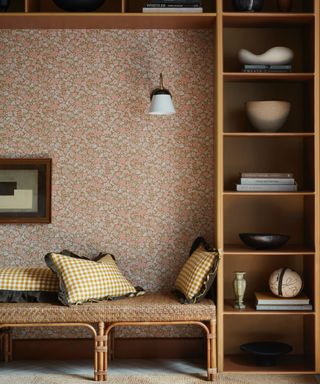
A pretty rattan bench sits next to a shelving unit made from wood.
(Image credit: Little Greene)
Organic styles like woven rattan and linen are no new invention, having long been used for homewares and furnishings across the globe. By utilizing these materials you’re not just creating a classic, chic and rustic home, you’re helping the environment. It’s important to use sustainable and organic sources within design and bamboo, wood and other natural fibers are usually much more eco-friendly.
Nina Lichtenstein is a big believer in incorporating nature within design saying, ‘Sustainable materials like reclaimed wood and recycled metals will be a major focus, with pieces crafted to tell a story.’ Nina’s top styling tip is to ‘highlight eco-friendly furniture with greenery and woven rugs to enhance its organic charm.’
The importance of sustainability will see many consumers move away from fast furniture and invest in designs that can truly stand the test of time. But ensure your pieces are made from FSC-approved wood or other sustainable and fairly traded materials. The growing focus in design on natural products is not just to do with a revival of interest in craft; in a world increasingly dominated by synthetic materials and virtual reality, natural materials add a grounding, natural and human dimension to our environment, helping us feel more calm and happy.
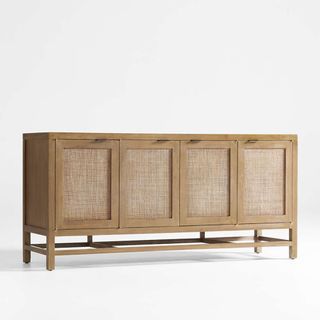
Blake 68″ Light Brown Teak and Rattan Storage Media Console
This Rattan Media Console is FSC-certified meaning it’s both sustainable and beautiful. Made from Teak and Rattan this piece combines luxury with natural materials.
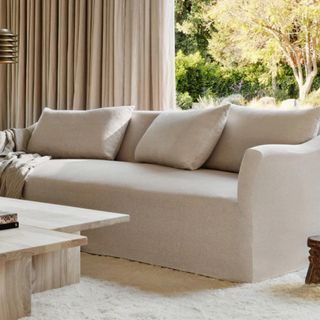
Linen is both a durable and luxurious material which couldn’t be more fitting for a communal piece like a sofa.
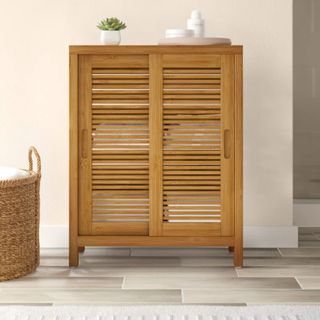
Ayden Solid Bamboo Wood Freestanding Bathroom Cabinet
Composed of wood and bamboo, this freestanding cabinet has a truly rustic charm that harks back to nature.
6. Marie Antoinette style
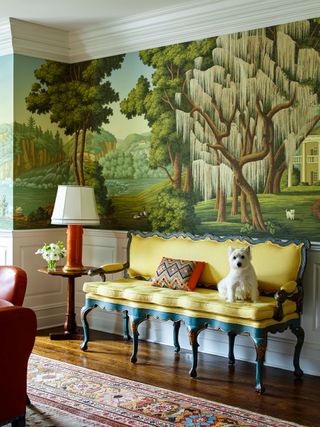
(Image credit: Katie Ridder)
Let them eat cake! Contrasting entirely to the popular curved furniture and organic trends, there will be an appreciative shift back to 18th-century furniture and decor styles. Lavish luxury is a style that for some will always signify taste and gentility despite its age and historic roots. Rococo-style decadence has been a popular furniture style for years, but in 2025 we will witness a refreshing renewal of the classic look.
Daybeds were a popular type of furniture in the 18th century and are becoming a bit of a household staple, blurring the lines between bed and sofa. They’re the perfect piece to position in an office or lounge area, acting as a source of rest and recuperation.
Although decadent pieces may seem a little incongruous in a domestic setting there are many ways to integrate opulent pieces into the home. Try placing a silk chaise lounge alongside a dramatic painted mural or hanging tapestry for a luxurious, antique look. Or, elevate your bedroom furnishings with a shabby-chic style dresser and an ornate glass mirror.
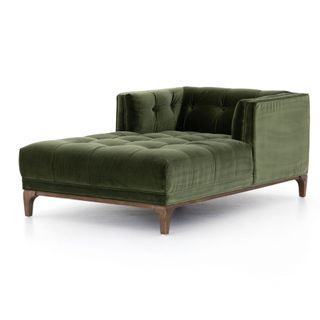
If overly lavish-style furniture isn’t your thing, this Apollo Chaise Lounge takes a more minimal approach with its velvet finish and quilted upholstery.
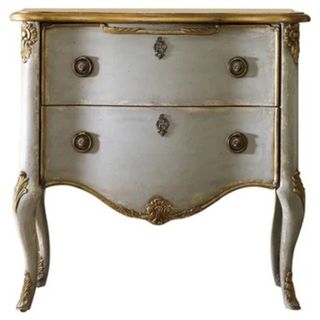
French 2 – Drawer Nightstand
A classic piece that would pair beautifully beside a decadent bed frame. Adorn with a vase of flowers and an ornate table light for the ultimate French look.
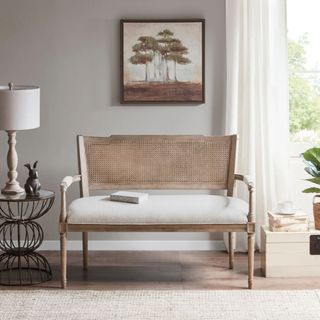
Madison Park Garfield Beige Reclaimed Natural Settee Beige
This wooden, neutral settee is a paired-back take on antique-style French furniture.
7. Vintage and thrifted finds
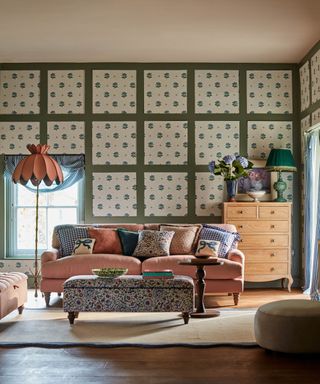
(Image credit: DFS)
Continuing with the retro and sustainable themes, it is unsurprising that decorating with vintage, pre-loved furniture is having a welcome resurgence for furniture trends. We’ve seen vintage style influence all aspects of designs, providing a cozy charm and appreciation towards handmade and thought-out design.
Sophie Salata, of the vintage furniture website Vinterior, says that there’s nothing more sustainable than buying pre-loved. ‘We believe we will continue to see the momentum of vintage furniture buying into 2025. Environmentally friendly furniture choices become the go-to way to add character to your home. It’s a win-win.’
The vintage look often combines both elegance and charm, so we can see why designers are incorporating this traditional style in new projects and furniture designs.
8. Statement stone
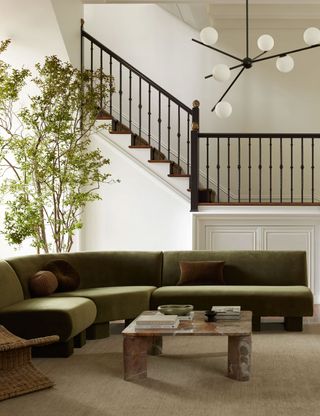
(Image credit: Lulu and Georgia)
Beautiful and luxurious natural stones such as marble and granite will always prove timeless in interior design, but 2025 will see these enduring and durable materials become even more present in the home, and not just reserved for kitchens and bathrooms.
‘Statement stone is forecast to be a big upcoming trend in the world of interiors. From travertine, and marble to onyx, stoneware brings a sense of luxury to everyday interior items and adds brightness to a space. The timeless material will be seen throughout the home with bold pieces in the kitchen and bathroom, to coffee tables and cabinets, and smaller decorative accessories including trays, candlesticks, lamp bases, bowls and bookends.’ says Harriet Pringle from Narchie.
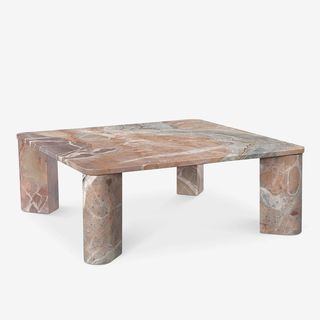
Angular and smooth, this clay colored coffee table is the ultimate chic statement in any room.
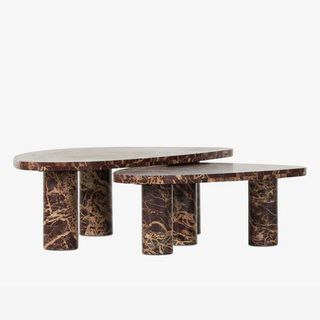
Merlot Marble Coffee Table (Set of 2)
These Merlot Marble Coffee tables are enviably luxurious and sleek. Try pairing them side-by-side or scatter around your home to bring a touch of grandeur.
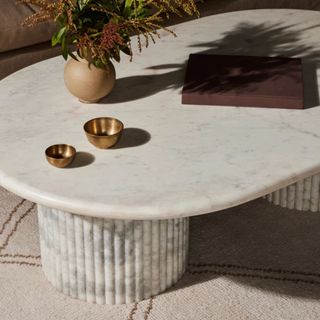
Four Hands Oranda Coffee Table
The Four Hands Oranda table is made of smoothly-finished, fine-quality marble and is supported by detailed fluted pillars.
9. Eclecticism and individualism
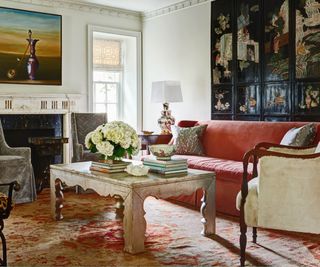
(Image credit: Gray Walker Interiors, PC Dustin Peck)
Working in unison with other furniture trends such as the use of sustainable materials and pre-loved purchases, 2025 will see many of us carefully considering every piece of furniture in our home, establishing a more ‘collected’ and individual look.
Designer Chris Cox explains, ‘People are increasingly valuing artistry and craftsmanship, recognizing the depth of character that these objects add to a space. Rather than rushing to fill their homes with mass-produced items, individuals are taking time to curate collections of carefully crafted pieces and antiques that reflect their unique tastes and stories.’
This will result in not only an elegant blend of the old with the new but a unique union of styles and themes. Charu Gandhi, founder of global design studio, Elicyon, explains, ‘Over the last decade, there has been a pattern of trends being influenced by historical references and I think this will grow ever stronger. I believe we are going to see an integration of vintage and contemporary design aesthetics to create one cohesive scheme throughout a room or home.’
10. Bobbin furniture
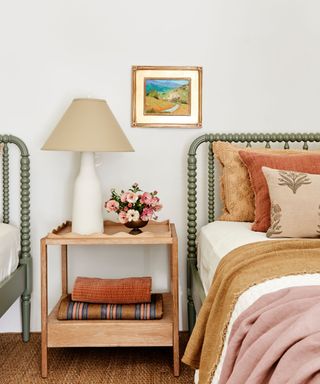
(Image credit: Sara Tramp)
Lastly, (but by no means least) comes the playful and whimsical bobbin furniture trend. It’s an instantly recognizable style that you would’ve seen featured in designer’s creations all year. Bobbin pieces are made from pillars of stacked uniform balls, distinctly rounded in shape.
Sophie Salata outlines the growth of this trend, which will only increase into the upcoming year. ‘Bobbin is back, but did it ever really leave? Last quarter saw a 28% increase in sales of bobbin furniture, and this trend looks set to continue into 2025. Classic with a touch of whimsy, bobbin is a great way to add subtle interest to a space, and a great ‘starter’ piece of vintage furniture whilst still adding something special to a space.’
FAQs
What color of furniture is in for 2025?
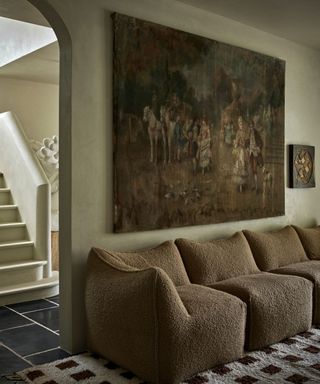
(Image credit: Montana Labelle Design)
As we have discussed, natural materials such as wood, and earthy, grounding color trends with a focus on green, brown, and cream shades will be popular throughout 2025, helping to establish a calming, and tranquil atmosphere. Caramel tones are a good transitional, warm shade that will both frame a space and pair well with colorful decor and furnishings.
Anna Sheridan knows a thing or two about color. She says that ‘Brown furniture is the perfect answer for the new neutral. The color works especially well when used on soft furnishings, and paired with layers of texture. However, not all brown colors are faultless, so be careful to do your research and sample extensively!’
However, many of us are using furniture pieces such as sofas and lounge chairs to make a real impact and statement with color and pattern, with rich jewel tones and playful, primary color palettes also favored by designers.
Ann Marie Cousins, founder of AMC Design supports this and says, ‘There has been more of a focus on creating surroundings that heavily influence our moods and wellness, so introducing a vibrant color palette is a great place to start. Explore your more playful and nostalgic side and experiment with patterns and textures to create the ultimate uplifting atmosphere in your home.’
Is painted furniture still popular for 2025?
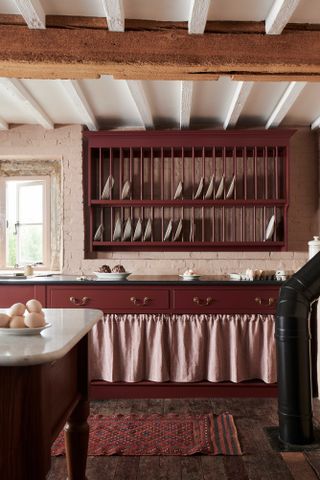
(Image credit: Devol)
We envisage painted furniture still being at the forefront of interior design – mainly due to its versatility and the ability to customize looks. One of the most appealing and varied finishes for cabinetry, paint lends itself to both the classic looks of the traditional home, and to more modern linear designs.
Sophie adds that ‘Buyers have taken a fancy to more playful pieces, with sales of hand-painted furniture and stripes up in the last quarter. We believe your home should bring you joy, reflecting your eccentricities to create a truly distinctive space.’
The advantage is in its almost limitless choice of colors, allowing you free rein to express yourself, whether your home is period or contemporary, country or urban. And you can always re-paint if you want a change or update in the future.
The year ahead is filled with exciting trends, but we are most looking forward to purchasing some chic, comfortable and playful furniture pieces.
Embracing timeless design is always a good choice, but it’s also exciting to discover new furniture trends and give your space a fresh update with the latest in interior design.
Whether you’re in the market for a new sofa, side table, or just curious about the 2025 furniture trends predicted by designers, the new year is a great time to explore the latest interior design trends and consider updating your existing furniture pieces.
To help you navigate the world of style and get expert insights, we’ve gathered the top furniture trends for the upcoming year.
10 furniture trends set to dominate design in 2025
There’s a lot to unpack when it comes to 2025 furniture trends, from elegant wooden furniture to statement stoneware and nods to vintage styles. These are the top 10 trends and design ideas that will shape furniture styles in the coming year.
1. Finely crafted wooden furniture

(Image credit: Hoedemaker Pffeifer / Haris Kenjar)
According to Tim Pfeiffer, interior design partner at Hoedemaker Pfeiffer, finely crafted wooden furniture will continue to be a timeless choice, bringing warmth and natural character to our spaces. Handcrafted artisanal furniture from bespoke woodworker designers is expected to evolve and remain a staple in interior design.
Joanna Hauptman, co-founder of Hyde House, also sees a return to timber in its natural state, with a focus on reclaimed wood and veneers like oak and mahogany. Specialist finishes such as birds eye maple and walnut burr can add depth and create a design statement in a room.
2. Fluted kitchen cabinetry

(Image credit: deVOL Kitchens / Good Bones London)
Fluted cabinets offer a textural and rustic finish, evoking a vintage charm reminiscent of wooden shutters. As part of the vintage-style decor trend, fluted cabinetry brings a touch of nostalgia to modern interiors.
DeVOL Kitchens has incorporated fluted cupboards in their ‘Haberdasher’s style’ kitchens, drawing inspiration from midcentury apothecary and sewing stores. Helen Parker, Creative Director at deVOL Kitchens, explains that the Haberdasher’s cupboards feature a unique fluted finish inspired by tambour doors popular in the mid-century era.
During the design process, the DeVOL team aimed for authenticity in creating a retro-inspired kitchen. Paul O’Leary, Founder of deVOL Kitchens, describes the process of crafting the fluted cupboards, which are made from oak slats slotted into a door frame with horizontal dividers that align with the drawers. The result is a statement piece that blends elements from the ’30s to the ’70s.
3. Soft and inviting curves

(Image credit: Angel O’Donnell)
Curved furniture, known for its soft and inviting qualities, has been a popular choice for the past year and shows no signs of slowing down. The comfort and ease provided by curved lines on furniture pieces make them a lasting trend.
Gray Walker, director of Gray Walker Interiors, plans to continue incorporating curved surfaces and plush furniture in her designs, emphasizing the comfort and softness that curved edges bring to a room.
Choosing curved furniture for communal spaces can help soften the atmosphere and eliminate any harshness that angular pieces might introduce. However, it’s important to strike a balance, as too many curves can create a playful feel. Nina Lichtenstein recommends integrating round rugs and angular accents like geometric art or rectangular tables to complement the softness of curved furniture.
London-based interior stylist Anna Sheridan sees a shift towards angular modular sofas as a sleeker alternative to curved sofas. Pairing an angular modular sofa with a fluid and organic-shaped coffee table can create a modern and stylish look.
4. Unexpected upholstery

An upholstered statement ottoman in a vibrant living room designed by Prospect Refuge.
(Image credit: Prospect Refuge Studio, Caylon Hackwith)
Fabric surfaces, like upholstered furniture, bring tactile comfort and warmth to communal spaces, creating a welcoming and inviting environment. While original pieces with hard surfaces are beautiful, too many of them can give a room a stark and cold feel. Upholstered furniture helps create a warm and inviting atmosphere from the moment you enter a room.
Although upholstery has been a traditional technique for centuries, there’s a resurgence in using unexpected fabrics and furniture to create striking and unique designs.
Victoria Sass, design director at Prospect Studio, has been experimenting with uniquely upholstered designs and is excited to see the trend grow in popularity in 2025. She recommends thinking beyond sofas and chairs and exploring new and inventive ways to incorporate upholstery into different pieces of furniture. For example, creating a skirted coffee table or a fully upholstered custom desk can add a touch of softness and creativity to a space.
5. Sustainable materials

A rattan bench next to a wooden shelving unit.
(Image credit: Little Greene)
Organic materials like woven rattan and linen have long been used in homewares and furnishings, offering a classic, chic, and rustic look. By incorporating these materials, you not only create a stylish and cozy home but also contribute to environmental sustainability. Using sustainable and organic sources such as bamboo, wood, and natural fibers is not only eco-friendly but also adds a touch of nature to your design.
Nina Lichtenstein emphasizes the importance of incorporating nature into design, highlighting the use of sustainable materials like reclaimed wood and recycled metals. She suggests pairing eco-friendly furniture with greenery and woven rugs to enhance their organic charm.
The focus on sustainability is prompting consumers to move away from fast furniture and invest in designs that stand the test of time. It’s essential to choose pieces made from FSC-approved wood or other sustainable and fairly traded materials. The resurgence of natural products in design serves as a counterbalance to the synthetic materials dominating the modern world, offering a grounding and calming effect on our environment.

Blake 68″ Light Brown Teak and Rattan Storage Media Console
This FSC-certified Rattan Media Console combines sustainability with luxury. Made from Teak and Rattan, this piece offers a blend of elegance and natural materials.

Linen is a durable and luxurious material that’s perfect for communal pieces like sofas.

Ayden Solid Bamboo Wood Freestanding Bathroom Cabinet
This freestanding cabinet made of wood and bamboo exudes rustic charm and a natural vibe.
6. Marie Antoinette style

(Image credit: Katie Ridder)
Contrary to the popular curved furniture and organic trends, 2025 will see a resurgence of 18th-century furniture and decor styles, including the lavish luxury associated with Rococo-style decadence. While some may view this style as outdated, it continues to exude taste and gentility, making it a timeless choice.
Daybeds, a popular furniture piece in the 18th century, are becoming a staple in modern homes, blurring the lines between bed and sofa. They offer a perfect spot for relaxation and rest in offices or lounge areas.
Although opulent pieces may seem out of place in a residential setting, there are ways to incorporate them tastefully. Placing a silk chaise lounge next to a dramatic painted mural or hanging tapestry can add a touch of luxury and antiquity to a room. Similarly, upgrading your bedroom with a shabby-chic dresser and an ornate glass mirror can enhance the overall aesthetic.

